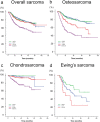Descriptive epidemiology and outcomes of bone sarcomas in adolescent and young adult patients in Japan
- PMID: 30121085
- PMCID: PMC6098838
- DOI: 10.1186/s12891-018-2217-1
Descriptive epidemiology and outcomes of bone sarcomas in adolescent and young adult patients in Japan
Abstract
Background: There have been fewer improvements in the clinical outcomes of adolescent and young adult (AYA) patients with cancer than for children and older adults, possibly because fewer studies focus on patients in this age group. The aims of this study were (1) to determine survival rates of bone sarcoma among AYAs in Japan (for comparison with other age groups), and (2) to establish whether belonging to the AYA age group at diagnosis was correlated with poor cancer survival in Japan.
Methods: A total of 3457 patients diagnosed with bone sarcoma (1930 male and 1527 female) were identified from 63,931 records in the Bone and Soft Tissue Tumor (BSTT) registry, a nationwide Japanese database, from 2006 to 2013. The histologic subtypes of bone sarcoma were osteosarcoma, chondrosarcoma, and Ewing sarcoma. The primary endpoints for prognosis were the occurrence of tumor-related death. We compared the epidemiological features of AYAs with other age groups. The cancer survival rates were calculated using the Kaplan-Meier method. Cox proportional hazards models were used to analyze the prognostic factors for cancer survival.
Results: The majority of AYA had osteosarcoma 631 (56.2%), while 198 (17.6%) had chondrosarcoma. The frequency of bone sarcoma occurrence was highest among AYA patients, who accounted for a marked proportion of patients with each type of sarcoma. With the exception of sarcoma type, AYA patients did not significantly differ from patients in other age groups for any of the investigated clinicopathological parameters. Cancer survival of AYA patients was significantly higher than in the elderly. Univariate and multivariate analyses revealed that AYA status was not a predictor of poor cancer survival. However, older age (≥65 years) was a predictor of poor cancer survival in patients with overall bone sarcoma, osteosarcoma, chondrosarcoma.
Conclusion: This epidemiological study is the first to investigate AYA patients with bone sarcoma using the nationwide BSTT Registry. We found that cancer survival of AYA patients was significantly higher than that of the elderly. AYA status was not a predictor of poor cancer survival in Japan.
Keywords: Adolescent and young adult; Bone sarcoma; Cancer survival; Database; Japan.
Conflict of interest statement
Ethics approval and consent to participate
The research has been approved by the Ethic Committee of the Japanese Orthopaedic Association on March 17, 2016. This was a retrospective study carried out using data from the Bone and Soft Tissue Tumor registry; the authors were not involved in the collection of this data. Patients were informed that their data would be used for research and their data were de-identified before addition to the database. Retrieval of the data from this database occurred in an unlinked fashion. As the data had been anonymized, the Ethical Guidelines for Epidemiological Research (Ministry of Education, Culture, Sports, Science and Technology, and Ministry of Health, Labour and Welfare of Japan), which require ethics approval and informed consent, are not applicable to this study. Based on the Ethical Guidelines on Biomedical Research Involving Human Subjects (Ministry of Education, Culture, Sports, Science and Technology, and Ministry of Health, Labour and Welfare of Japan), clinicoepidemiological studies conducted on medical databases constitute research carried out on pre-existing material and information, that did not require any interventions or interactions with patients. For such studies, including this study, obtaining written informed consent from patients is not compulsory.
Consent for publication
Not Applicable.
Competing interests
The authors declare that they have no competing interests.
Publisher’s Note
Springer Nature remains neutral with regard to jurisdictional claims in published maps and institutional affiliations.
Figures

Similar articles
-
Statistics of bone sarcoma in Japan: Report from the Bone and Soft Tissue Tumor Registry in Japan.J Orthop Sci. 2017 Jan;22(1):133-143. doi: 10.1016/j.jos.2016.10.006. Epub 2016 Nov 12. J Orthop Sci. 2017. PMID: 27847134
-
Bone sarcoma incidence in the Netherlands.Cancer Epidemiol. 2019 Jun;60:31-38. doi: 10.1016/j.canep.2019.03.002. Epub 2019 Mar 20. Cancer Epidemiol. 2019. PMID: 30903831
-
Homogenous and Heterogenous Prognostic Factors for Patients with Bone Sarcoma.Orthop Surg. 2021 Feb;13(1):134-144. doi: 10.1111/os.12851. Epub 2020 Dec 10. Orthop Surg. 2021. PMID: 33305494 Free PMC article.
-
Diagnoses, treatment, and oncologic outcomes in patients with calcaneal malignances: Case series, systematic literature review, and pooled cohort analysis.J Surg Oncol. 2020 Dec;122(8):1731-1746. doi: 10.1002/jso.26205. Epub 2020 Sep 24. J Surg Oncol. 2020. PMID: 32974945
-
Clinical trial enrollment of adolescents and young adults with sarcoma.Cancer. 2017 Sep 15;123(18):3434-3440. doi: 10.1002/cncr.30757. Epub 2017 May 11. Cancer. 2017. PMID: 28493547 Free PMC article. Review.
Cited by
-
Amputation surgery associated with shortened survival in patients with localized extremity bone sarcoma.J Orthop. 2024 Mar 18;54:124-130. doi: 10.1016/j.jor.2024.03.017. eCollection 2024 Aug. J Orthop. 2024. PMID: 38560589 Free PMC article.
-
A short-term three dimensional culture-based drug sensitivity test is feasible for malignant bone tumors.Hum Cell. 2023 Nov;36(6):2152-2161. doi: 10.1007/s13577-023-00982-8. Epub 2023 Sep 14. Hum Cell. 2023. PMID: 37707773
-
Surgical management of sarcoma in adolescent and young adult patients.BMC Res Notes. 2020 May 26;13(1):257. doi: 10.1186/s13104-020-05107-0. BMC Res Notes. 2020. PMID: 32456671 Free PMC article.
-
Incidence Patterns and Outcomes of Ewing Sarcoma in South Korea (1999-2017): A Retrospective Analysis Using Korea Central Cancer Registry Data.Cancer Res Treat. 2022 Apr;54(2):590-596. doi: 10.4143/crt.2021.311. Epub 2021 Jul 20. Cancer Res Treat. 2022. PMID: 34281296 Free PMC article.
-
Incidence of primary bone sarcomas in Iranian population (2008-2015): A national population-based study.Caspian J Intern Med. 2022 Fall;13(4):741-748. doi: 10.22088/cjim.13.4.741. Caspian J Intern Med. 2022. PMID: 36420339 Free PMC article.
References
-
- Children’s Oncology Group, SEER Program (National Cancer Institute (U.S.)). Cancer epidemiology in older adolescents and young adults 15 to 29 years of age : including SEER incidence and survival, 1975–2000. Bethesda: U.S. Dept. of Health and Human Services, National Institutes of Health, National Cancer Institute; 2006. x, 205 p. p.
Publication types
MeSH terms
LinkOut - more resources
Full Text Sources
Other Literature Sources
Medical

